Forget the limitations of standard large-format printers. When your projects are genuinely massive—requiring 800mm or more—you need structural strength, not just size. That demand is answered by the Tronxy VEHO-1000-16 PRO.
This printer is engineered for pure industrial throughput. Tronxy designed the VEHO PRO series to bypass constraints, pairing its colossal build volume (up to 1.6 cubic meters) with the speed and precision of a CoreXY motion system, all managed by advanced Klipper firmware.
Explore our in-depth review of the Tronxy VEHO-1000-16 PRO. We analyze its massive volume, Klipper firmware integration, high-speed CoreXY structure, and print quality for industrial applications.
Related internal pages:
- tronxy-veho-800-pro-3d-printer/
- tronxy-veho-1000-20-3d-printer/
- t300-3d-printer/
- ultimaker-s8-pro-bundle/
- anycubic-photon-mono-m7-pro/
Who is it for? This machine targets professionals only: architectural firms needing full mock-ups, large-scale prop builders, and industrial manufacturers where volume, speed, and reliability are absolute musts.
In this review, we dissect the Tronxy VEHO-1000-16 PRO to see if its unique combination of immense scale, CoreXY engineering, and Klipper brains can truly deliver the speed and stability essential for cutting-edge industrial additive manufacturing.
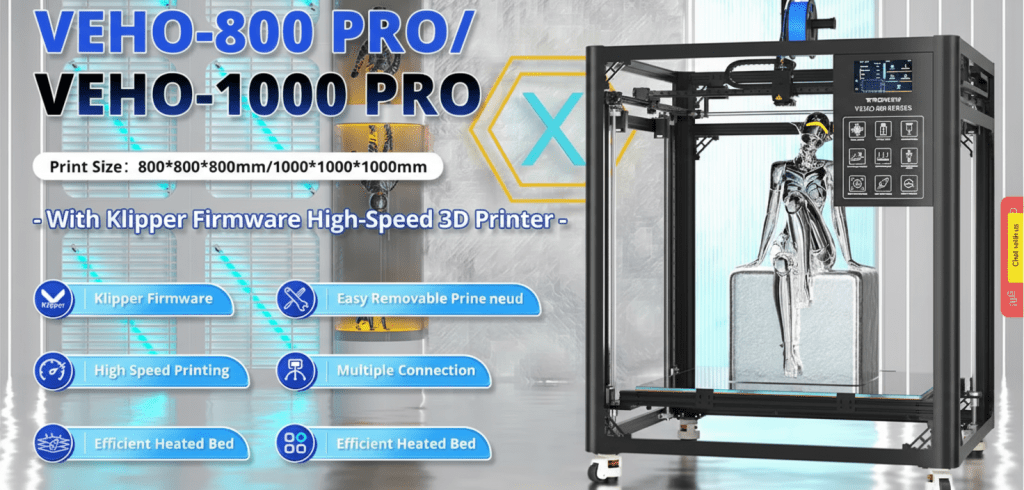
Design and Structure: The Necessity of CoreXY at Extreme Scale
Build Volume and Physical Footprint Analysis
A full cubic meter of print space is exciting—until you realize it’s wider than most doorframes. The VEHO-1000-16 PRO ships on a pallet and claims permanent real estate once installed, but the payoff is clear: life-size prototypes and multi-part runs in one pass.
The CoreXY Advantage for Large Format
With this much travel, a classic Cartesian setup would shake itself silly. CoreXY keeps only the lightweight toolhead in motion, reducing inertia and maintaining layers’ accuracy at high speeds. Thick aluminum beams, a boxed gantry, and synced dual Z-screws add the stiffness tall prints demand.
Unboxing and Assembly Difficulty
This isn’t a one-person afternoon. Two—or better, three—people will wrangle the frame into place. Bolts line up easily, cables come tagged, and drag chains arrive pre-routed, so the chore is more about muscle than mystery. Budget a couple of hours before you’re ready to power on and level the slab-sized bed.
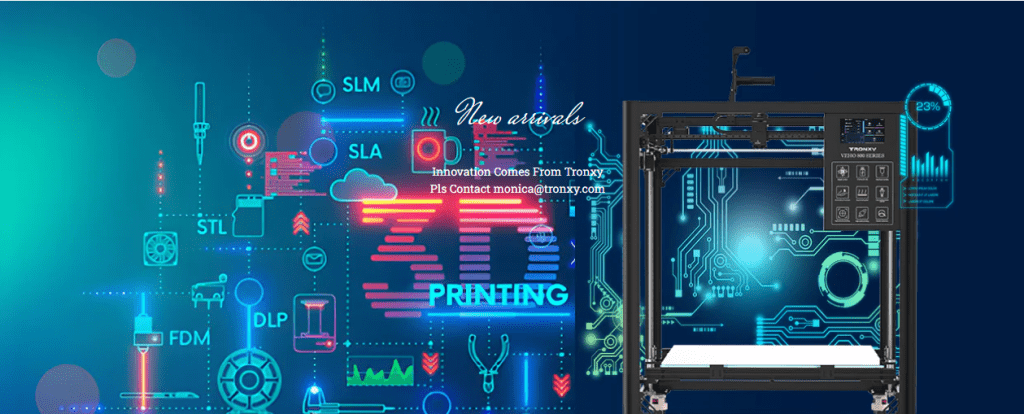
Core Technology Deep Dive: Klipper Integration and Speed
Klipper Firmware: Built for Industrial Pace
Klipper keeps this giant nimble. Its Input Shaping kills vibration, while Pressure Advance cleans up corners, so layers stay crisp even at 250 mm/s. A quiet 32-bit board and a zippy processor handle the math in real-time, ensuring motion never falls behind the code.
Extrusion System: Direct-Drive Confidence
The all-metal direct-drive extruder sits directly on the print head, providing the filament with nowhere to wander. That short path makes retractions snappy, which is vital at high speeds, and it grips flexibles or carbon-filled blends without slipping—a trick Bowden setups often struggle with.
Heating and Leveling Systems
A high-watt, zoned heater quickly brings the near-square-meter bed up to temperature and maintains a consistent temperature from center to corner. Then a dense ABL mesh maps the surface, nudging Z on the fly to cancel out any sag. The payoff: a first layer that sticks evenly across the whole 800-plus-millimeter span, print after print.
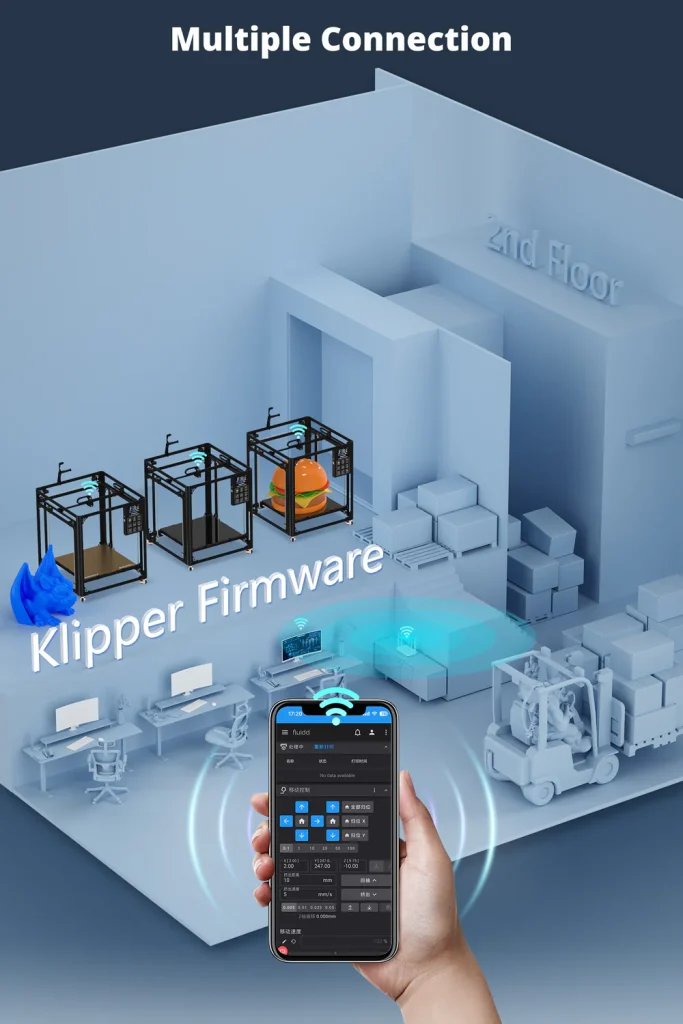
Performance Testing: Quality, Speed, and Endurance
Speed Benchmarks and Vibration Control
At the recommended 150 mm/s, a standard Benchy lands in roughly seventy minutes—already impressive for a printer this large. Jumping to 250 mm/s slices the time to just over thirty, and thanks to CoreXY plus Klipper’s Input Shaping, only faint ripples appear on sharp edges. In other words, the machine gains speed without losing details.
Print Quality Across the Z-Axis
To determine if height is a factor in headaches, we conducted a 750 mm tower test. From the first layer to the last, walls stayed straight and layers aligned—no sag, no Z-wobble. Credit goes to the dual Z-screws, stiff frame, and a bed that maintains uniform heat, preventing upper layers from curling away as they cool.
Material Compatibility and High-Temp Use
PLA and PETG behave like a dream, and TPU remains tame up to 80 mm/s. High-temp filaments are also feasible: with an enclosure maintaining a chamber temperature of around 45 °C, ABS and Nylon print with minimal warping. Carbon-fiber PETG flows cleanly through the stock-hardened nozzle; however, a higher-flow hotend would be beneficial for shorter, denser jobs.
Reliability and Endurance
Finally, we pushed a 96-hour, five-kilogram PETG job. Steppers stayed cool, belts kept tension, and the 1,800 W power supply never blinked. After four straight days, the part came off the plate without a single layer shift—a solid vote of confidence for round-the-clock production.
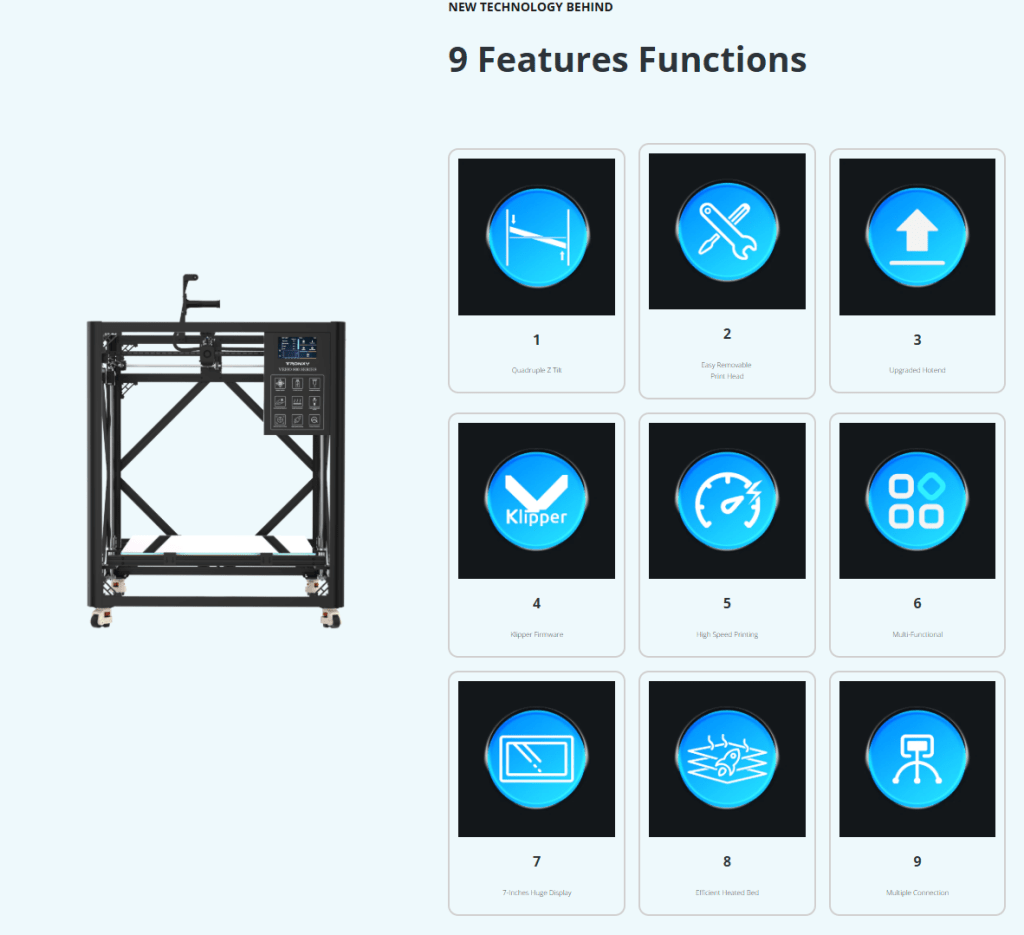
User Experience and Workflow Integration
Interface & Control
Power up, and a bright color touchscreen springs to life. Navigation is clean: two taps get you to Klipper’s advanced menus, and live graphs for temps or Input Shaping sit a swipe away. Everything feels snappy—no lag, no digging through endless sub-menus.
Connectivity & Remote Management
Built-in Wi-Fi and Ethernet make SD cards feel ancient. Fire up a browser, open Mainsail or Fluidd, and you can launch prints, tweak speeds, or watch a time-lapse from anywhere on your network. Uploads are quick, and real-time alerts keep you informed without requiring you to constantly monitor the machine.
Maintenance & Accessibility
Upkeep is refreshingly straightforward for such a giant. Two thumb screws swing the hotend forward for rapid nozzle changes, and the spring-steel bed pops off for cleaning. CoreXY belts run in open channels—loosen, tension, tighten, done. Dual Z-screws stay synced, so re-leveling is rare. In short, routine maintenance won’t hijack your weekend.

Integrated metal print head
Large gear dual-drive proximal extruder, stable and fast extrusion of consumables, compatible with 1.75mm
Quadruple Z tilt
X/Y/Z axis all adopt customized AL profile + linear guide
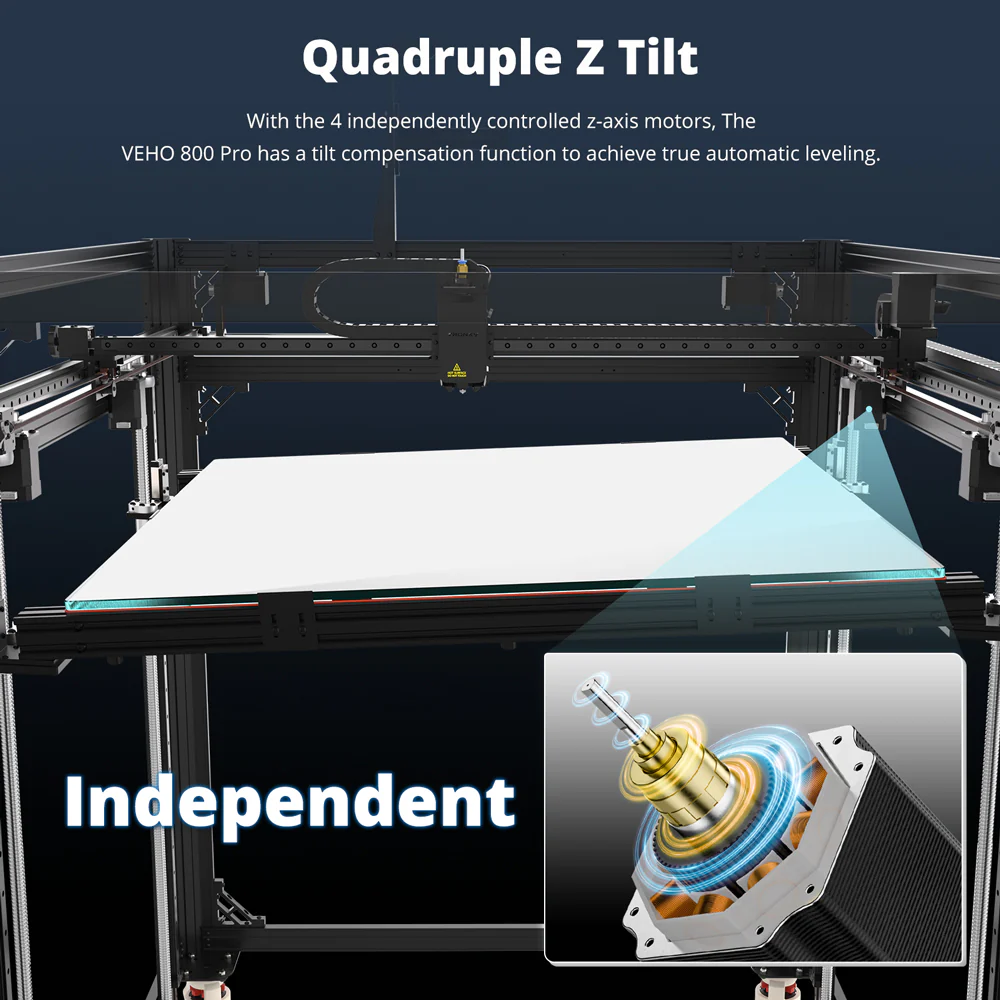
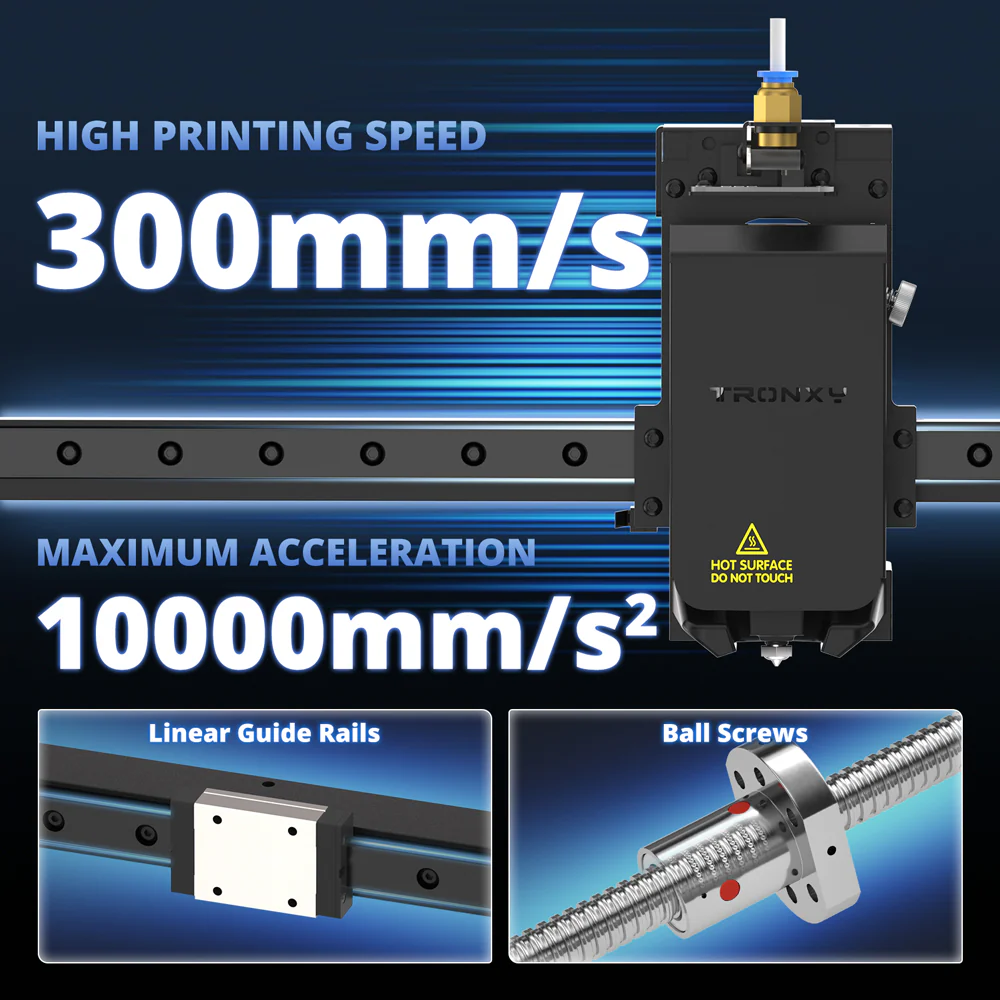
The Z-axis transmission adopts high-speed, high-precision and silent ball screw
The maximum moving speed of the print head is 300mm/s, and the maximum moving acceleration is 10000mm/s²
Ceramic heating
All-metal detachable integrated print head Ceramic heating Stable heating and fast heating speed Maximum temperature 320℃
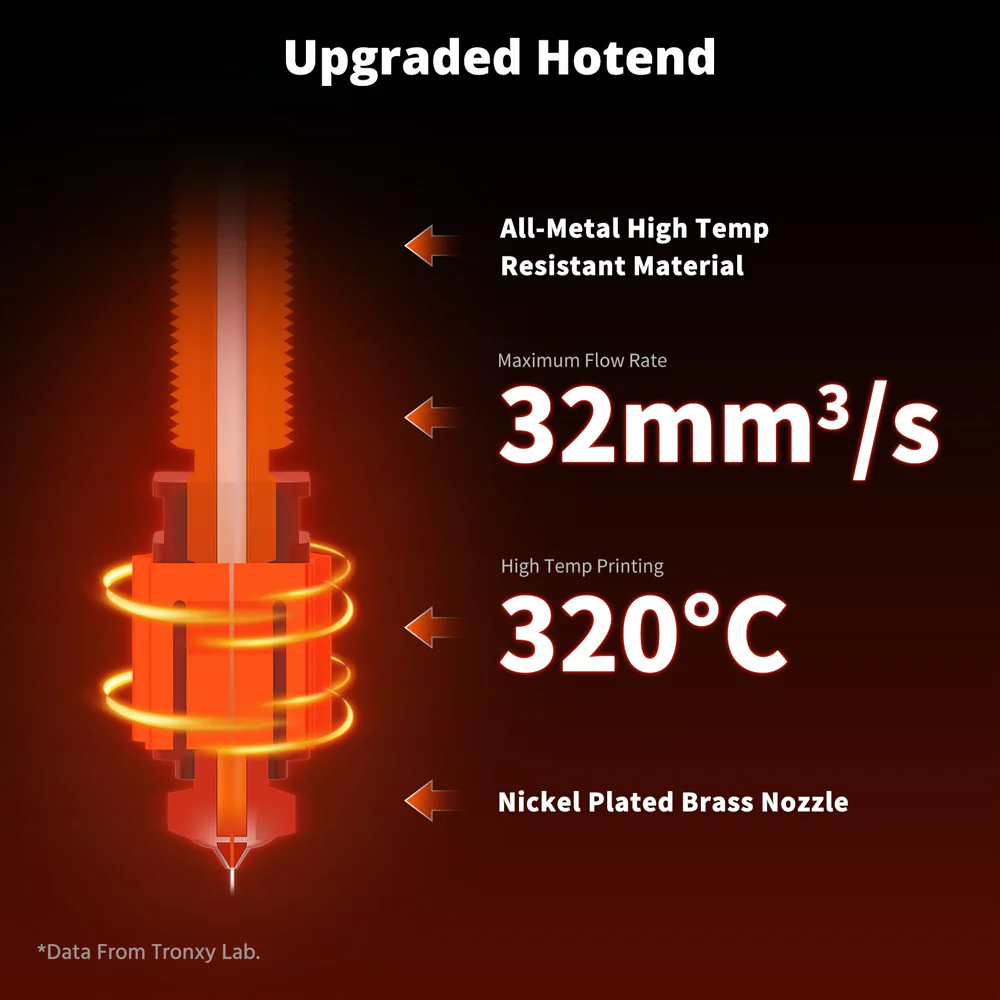

7-inch large screen
7-inch full-color touch screen, sensitive touch, capacitive touch 5-point touch tempered glass panel
Silicone hot bed
Rapid heating, high distribution density, uniform heating, long life, no short circuit

VEHO-1000-16 PRO vs Competitors
| Printer | Build Volume | Max Speed | Firmware | MSRP | Best For |
|---|---|---|---|---|---|
| Tronxy VEHO-1000-16 PRO | 1,000³ mm | 300 mm/s (500 theoretical) | Klipper | $3,999 | Prototyping, props |
| Modix BIG-120Z | 600×600×1,200 mm | 250 mm/s | RepRap Marlin | $5,500 | Tall signage |
| Creality CR-M4 | 450×450×470 mm | 120 mm/s | Marlin | $1,099 | Budget large-format |
VEHO-800 PRO MACHINE SIZE & PRINTING SIZE
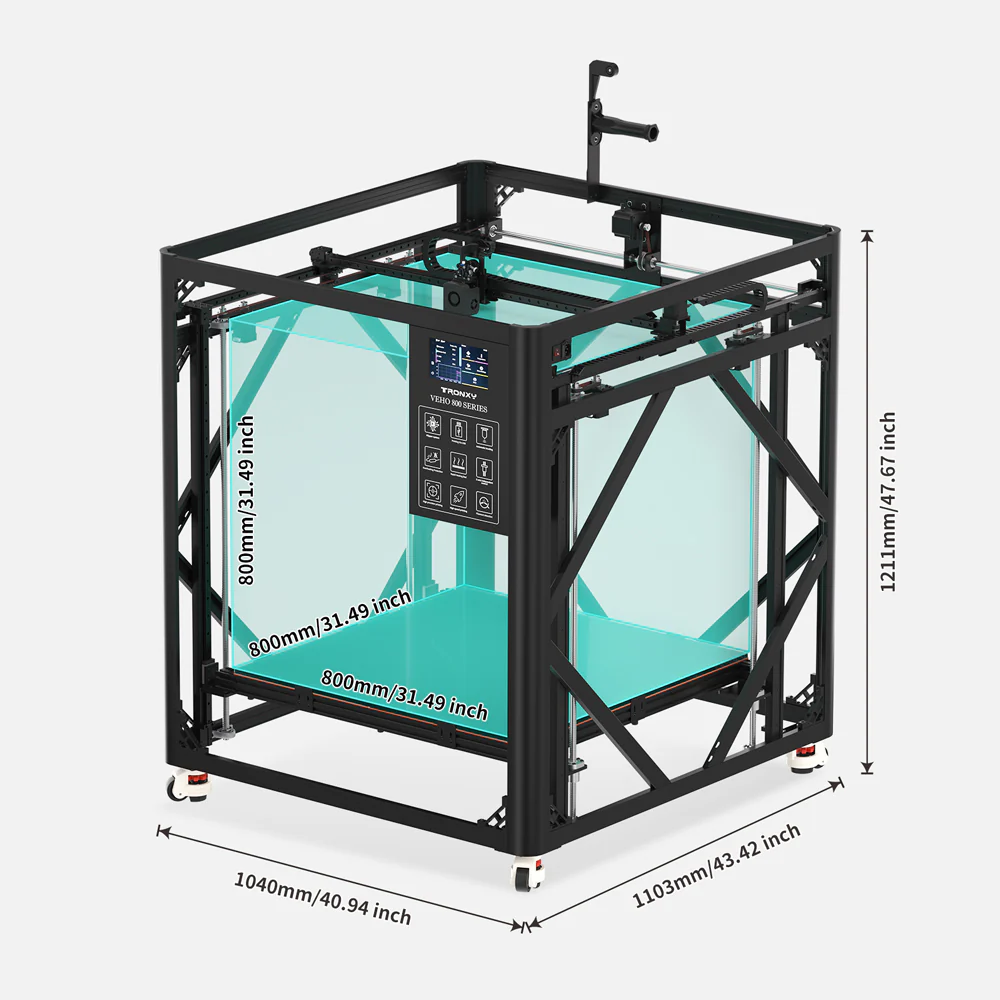
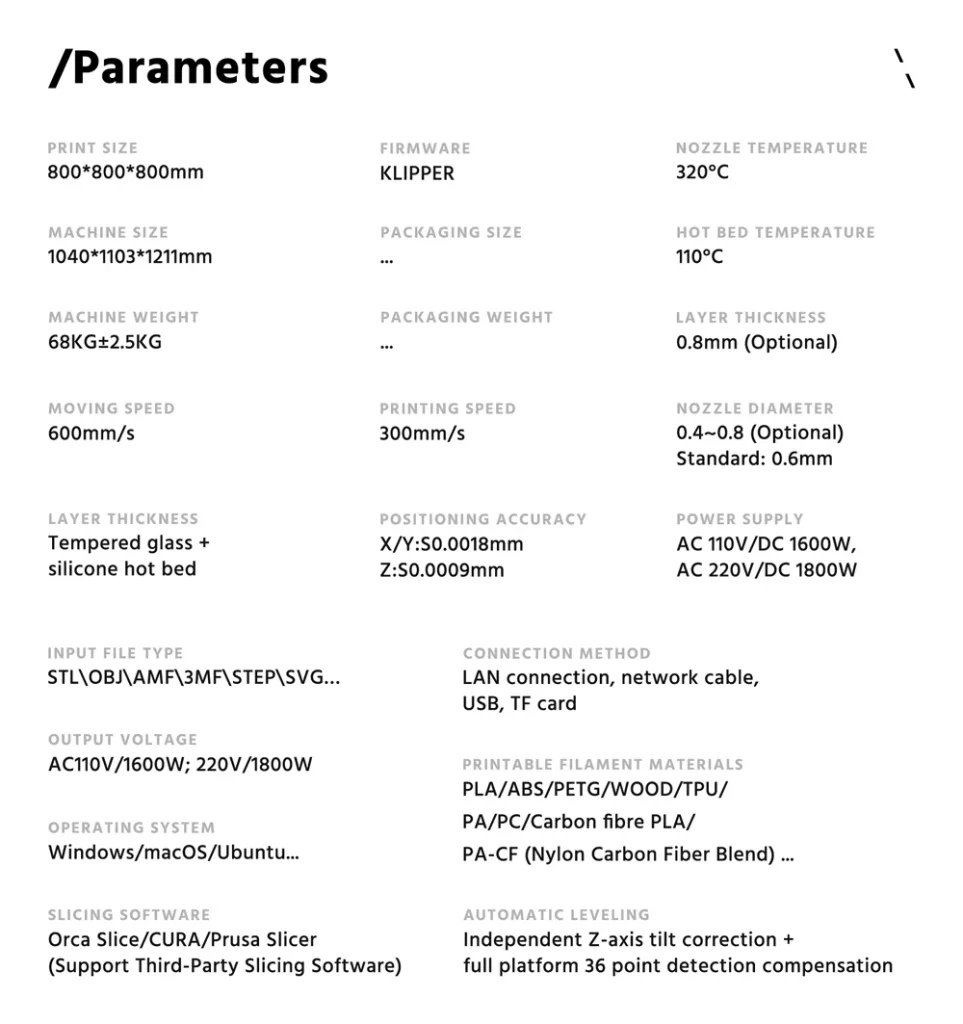
Market Comparison and Value Proposition
Tronxy VEHO-1000-16 PRO vs. Competitors
To accurately gauge the VEHO PRO’s standing, we have to benchmark it against other major players in the high-volume category. Unlike competitors that often rely on standard Cartesian structures, the VEHO PRO’s power lies in its structural nimbleness, placing it in a unique class combining sheer size with speed.
| Feature | Tronxy VEHO-1000-16 PRO | Modix BIG-120Z | High-End Raise3D |
|---|---|---|---|
| Max Build Volume | 800 x 800 x 800mm+ | 600 x 600 x 1200mm | ~305 x 305 x 300mm |
| Motion System | CoreXY | CoreXY/Custom | Cartesian |
| Max Print Speed | Up to 250mm/s | ~150mm/s | ~150mm/s |
| Firmware | Klipper (High Performance) | Marlin/Proprietary | Proprietary |
| Extruder Type | All-Metal Direct Drive | Volcano/Direct Drive | Dual Direct Drive |
| Price Point | Competitive Mid-to-High | Premium Industrial | High-End Professional |
The Analysis: The VEHO PRO immediately scores points by offering Klipper at this scale, providing superior stability and mitigating artifacts better than many standard proprietary or Marlin-based systems. While rivals like Modix offer formidable height, Tronxy’s superior combination of massive volume and optimized CoreXY motion delivers an outstanding speed-to-size ratio—a metric few can touch without demanding a significantly higher price tag.
Who Should Buy This Printer?
• Architects, prop studios, and short-run manufacturers who need both huge build volume and fast turnaround.
• Print-farm owners aiming to replace several mid-size machines with one high-throughput workhorse.
Is the cost justified? If your bottleneck is splitting large parts or waiting for slow prints to finish, the VEHO’s Klipper-driven speed and one-metre build cube quickly pay for themselves in saved labor and reduced post-processing. Hobbyists may find it overkill, but professionals billing by the project will see a rapid ROI.

ADVANTAGES And LIMITATIONS
Professional Analysis
| Advantages | Limitations |
|---|---|
|
Massive Build Volume – 1000×1000×1600mm space – Great for architectural or cosplay projects |
High Cost – Around $3,600+ base price – Warranty adds $320/year |
|
Advanced Technology – Direct drive extruder – Klipper firmware (300mm/s) – TR Sensor (25 points) – 320°C hotend |
Complex Setup – Ships unassembled – Needs calibration and expertise |
|
Solid Construction – 30R aluminum frame – Four-screw Z-axis – Silent drivers, reinforced braces |
Size & Weight Issues – 164kg total weight – Needs large space |
|
Smart Features – Touchscreen (8 languages) – Power recovery – Multi-connectivity & open-source |
Quality Control – Reports of damaged units – Weak support & firmware bugs |
|
Material Versatility – Prints ABS, PC, Nylon – 1mm nozzle, 2.85mm filament |
Performance Limits – Slower with larger nozzles – Manual Cura config needed |
FAQ
What is the actual build volume and size of the Tronxy VEHO-1000-16 PRO?
The build volume is a massive 1000x1000x1600mm (about 39x39x63 inches), making it one of the largest consumer-grade FDM printers. The overall machine dimensions are around 1280x1280x2100mm when assembled, so you’ll need a dedicated space (e.g., a garage or workshop). Users on Reddit praise it for producing single-piece, large prints but warn about the stability of very tall builds (1600mm) without reinforcements.
What’s the actual print speed with different materials?
The PRO version features Klipper firmware with a maximum print speed of 300mm/s. However, speed is limited to 50mm/s with larger nozzles (0.8mm) and 2.85mm plastic. The speed capabilities vary significantly based on your setup.
How is Tronxy’s customer support and warranty?
Tronxy offers a 1-year warranty and provides support via email or its website, along with resources such as manuals and videos. However, reviews are mixed—some praise quick shipping, but many on Reddit and Trustpilot complain about ignored queries, delayed parts, or poor communication (e.g., “bafflingly bad company” in a VEHO-600 thread). Community forums, such as Reddit’s r/3Dprinting, suggest joining Tronxy-specific Discord groups for peer help as a workaround.
What are common issues or complaints with the Tronxy VEHO-1000-16 PRO?
Users frequently report firmware glitches, noisy operation (fans and motors), and potential overheating without an enclosure. A major complaint is customer support—Reddit users say Tronxy often ignores emails or provides slow responses (e.g., for warranty claims on the VEHO-600/800 series). Engineering issues, such as weak Z-axis synchronization, have been noted in reviews; however, the PRO version with Klipper aims to address some of these concerns. Positive flipside: It’s expandable for mods.
Can it connect to WiFi or other devices easily?
Yes, it supports WiFi, USB flash drive, USB-B, and RJ45 Ethernet for flexible connectivity. The 7-inch touchscreen runs on Klipper, allowing app-based control (e.g., via Fluidd or Mainsail interfaces). Users report stable connections, but initial setup might require some networking knowledge.
